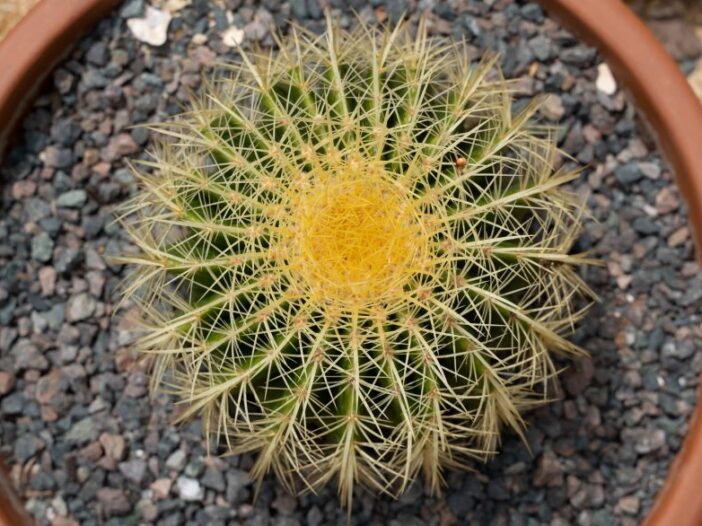
Inside our Frida and Her Garden exhibition, you can find one of the most impressive genera of succulents, round plants known as “barrel cactus.” They are as menacing as they are cute. The Spanish called them bisnaga, borrowed from an Aztec word that means “surrounded by thorns.” In scientific classification, the genus is known as Ferocactus, Latin for “fierce.” Mesoamericans used these rigid hook-shaped spines as needles and fishhooks. Evidence of the use of these cacti dates back to around 6,500 B.C.
There are around 30 species of Ferocactus. They can live up to 100 years and are terribly slow growing. Each plant can take 50 years to reach maturity. The largest, Echinocactus platyacanthus, is known to grow up to 10 feet tall. In addition to Mexico, other species of barrel cacti are endemic to the southern United States: Arizona (Ferocactus covillei), Texas and New Mexico (Ferocactus wislizeni), and California (Ferocactus cylindraceus and Ferocactus viridescens).
It is easy to imagine them in their native deserts, but many of us have never seen them planted in the ground as they are generally grown as container plants. Here, in the exhibition, they nestle among other endemic species of Mexico. Small red identification tags indicate that they are endangered in their native landscapes. The story of bisnaga is rife with tales of false legend, horrible survival advice, and sweet desert confections.

Barrel Cacti in Confections
Candy made from the internal pulp of these cacti has long been tradition in Mexico. Western pioneers sparked a wider fascination in cacti confections. One frontiersman in Arizona set his fortunes seizing an opportunity: Donofrio’s Crystallized Cactus Candy. Promotions were created to idealize the origins and mystique of the plant. False advertisements about Mexican rituals and “Toltec legend” spread. Romanticized ads, stories, and illustrations boasted a fake origin story designed to sell more product. It claimed that the Sun god, Huitzilopochtli, imprisoned a beautiful woman inside the cactus as protection, where a groom-to-be would have to remove thorns with his teeth. Depictions of this theme as a “traditional” wedding gift were printed on their boxes. In 1920, the Donofrio company produced 15,000 pounds of candy (about twice the weight of an elephant). Another company saw Donofrio’s success and replicated their business. In 1927 alone, the manufacturers produced 165,000 pounds.

In the 1948 John Wayne film 3 Godfathers, Wayne’s character, Robert Marmaduke, slices off the top of a barrel cactus and drinks its “water.” This “survival tip” has circulated for a long time, but most cacti adapted to protect their internal pulp. Acids and strong alkaloids create an unpleasant taste, and, worse, the chemical compounds can induce vomiting, diarrhea, or even temporary paralysis. Carrying plenty of water is the best survival tip for desert adventurers. If necessity presents, one could eat a cactus fruit, which does not contain the noxious chemicals, rather than risking the cactus pulp.
Cultivation & Care
In brighter contrast to their declining population in the wild, barrel cacti are thriving in cultivation. Ten to 15 million of them are grown around the world. In most regions, barrel cacti are grown in containers where they can be protected from prolonged freezes and excess rain. Southwest Florida, however, offers prime conditions for growing outdoors. These cacti thrive on neglect and full outdoor sun.

Care tips:
- Barrel cacti offer beautiful geometric forms to landscapes and do well in containers where they can be easily relocated when needed.
- They look great in a large, shallow pot with other cacti. The play on perspective makes them appear as a miniature desert scene. Pair them with other succulents that require the same care. Since their roots are slow growing and they prefer to be root-bound in containers, you won’t need to repot these communities for a long time.
- Water once per month and protect them from constant rain showers in the wet season. If planting in ground, great care should be taken. These plants are especially susceptible to root rot. Their roots need lots of perlite and gravel to promote excellent drainage. Plant them in gravel-rich fast-draining soil in an elevated location so that its roots will not be subjected to standing water. Do not water during winter months (November – February). Succulent species tend to go dormant in the winter months and are more at risk of rot.
- Wear thick gloves when handling and potting a barrel cactus. Cardboard (sometimes a few layers) can also be used to help protect against spines.
- These thick-skinned succulents do best in full outdoor sun or bright south-facing windows.

About the Author
Kristin Hood is an Executive Assistant for Naples Botanical Garden. She is a longtime plant enthusiast and co-owner of Plant Parenthood NYC.

